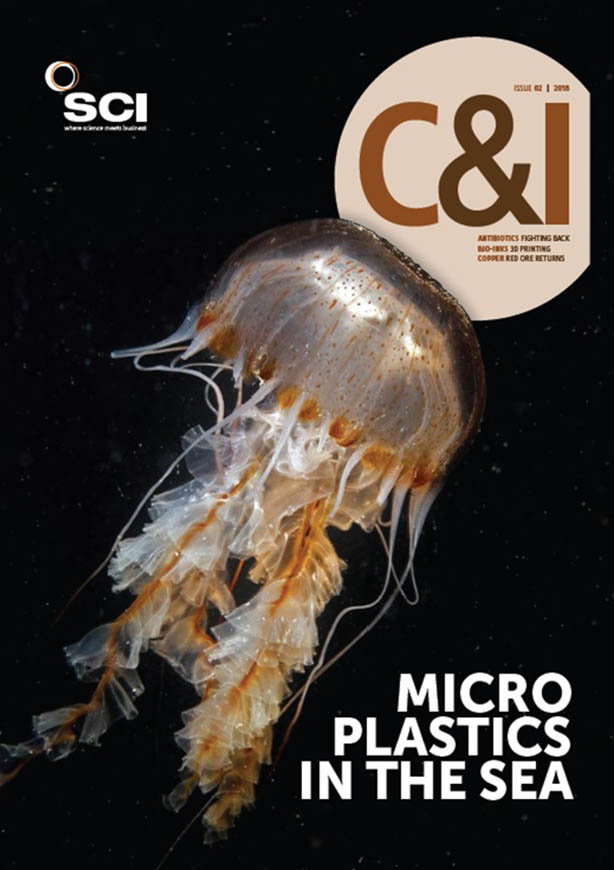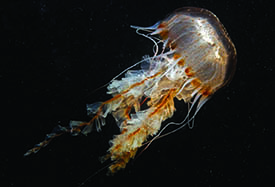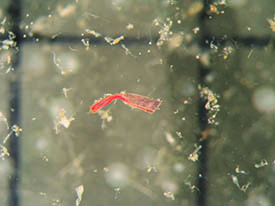Image: Thiomir Makovec
Could jellyfish mucus also offer a trap for microplastics?
Images of turtles trapped in plastic packaging or a fish nibbling on microfibres pull on the heartstrings. Yet many scientists studying plastics in the oceans remain open-minded on the longterm effects. While plastics shouldn’t be in our oceans, they say there is still insufficient evidence to determine whether microplastics – the very tiniest plastic particles, usually defined as being less than 1mm in diameter – are actually harmful.
On top of this, there is debate over how much plastic is actually in the sea and why so much of it remains hidden from view. Much of the research carried out to date is in its early stages – and has so far produced no definitive answers.
‘My concern is that we have to provide the authorities with good data, so they can make good decisions,’ says Torkel Gissel Nielsen, of the Technical University of Denmark (DTU). ‘We need strong data – and not just emotions.’
Gissel Nielsen leads a team of researchers who have discovered that levels of microplastics in the Baltic Sea have remained constant over the past three decades, despite rising levels of plastics production and use. The study – by researchers at DTU Aqua, the University of Copenhagen and Geomar in Germany – analysed levels of microplastics in fish and water samples from the Baltic Sea, taken between 1987 and 2015 (Science of the Total Environment; doi.org/10.1016/j. scitotenv.2017.10.101). ‘The result is surprising,’ says Nielsen. ‘There is the same amount of plastic in both the water and the fish when you go back 30 years.’ He claims that previous studies of microplastics levels were ‘snapshots’, while this is the first time levels have been studied over a longer period.
‘The study raises a number of questions, such as where the plastic has gone,’ he says. ‘Does it sink to the bottom, are there organisms that break it down, or is it carried away by currents? Some is in the sediment, some is in the fish, but we need to find out exactly how much plastic is there.
’ In the study, Sabrina Beer, a masters student at the University of Copenhagen, dissected more than 800 historical samples of fish and found microplastics in around 20% of them. This laborious process involved diluting the stomach contents in order to remove ‘organic’ materials, then checking the filtered contents under a microscope to determine the size and concentration of plastics. It illustrates the difficulty of quantifying plastics in any sample, says Gissel Nielsen.
Finding microplastics is challenging, as they can sometimes be of similar size to ‘natural’ species, from plankton to bacteria. ‘You must remove the biology to get a clear view of the plastics,’ he says.
Most of the plastics found in the samples were clothes fibres. The researchers assumed these pass undigested through fish within 24 hours. They also concluded that the constant level of plastics pollution in the Baltic was linked to the fact that the local population has remained constant over that time – and that there was no correlation with the general increase in global plastics production.
Nielsen is also critical of some studies that assess the effect of high concentrations of plastics on marine species, saying they do not replicate conditions in the real world. ‘All substances are toxic at a high enough level. It’s a matter of dosing,’ he says.
Searching high and low
Researchers at the National Oceanography Centre (NOC) in Southampton, UK, led by Richard Lampitt, are looking to answer a simple question: where are all the microplastics in the sea? ‘We don’t know if they are sinking, suspended, or whether they’ve already reached the sediment,’ he says. ‘We need to understand this, because there are huge uncertainties over their abundance.’
|
100,000t |
|
A scanning microscope with Fourier Transform Infrared capability promises to automate microplastics analysis with far higher speed and accuracy. |
Current estimates of microplastics on the surface layer of the sea is around 100,000 tonnes worldwide, he says; which is around 1% of the amount expected to flow into the sea every year. ‘We can only account for a tiny proportion of this,’ he says. ‘One reason could be that we are sampling incorrectly.’
One common technique drags a fine net – with 300micron mesh size – through the water. However, it could be that most plastic has degraded into even smaller particles – but is still there in high concentration. ‘That’s one way in which microplastics may have escaped detection,’ he says. To find the ‘missing material’, the NOC has been taking three main types of sample – some of them stretching back 20 years – to try and identify the location and concentration of microplastics.
The first type of sample is from sediment cores, which are extracted from the sediment – sometimes at depths of 5km – and later recovered. The technique can be used to look up to 10,000 years into the past, he says. ‘You can take ‘slices’ and find the microplastic concentration in each layer. The ‘oldest’ samples contain no plastic, and will act as ‘blanks’ to ensure that our samples are good.’
The second type of sample is from the ‘water column’. Here, water is collected from different depths – using a pump – for later analysis. The team has taken samples from the Porcupine Abyssal Plain Sustained Observatory (PAP-SO) in the North Atlantic, and at various points across the Atlantic Ocean.
The third type of sampling is from sediment traps. These are moored at depths of 3km, and collect setting material.
Lampitt says that the collection phase is largely complete, and that his team will now move on to analysing the samples with a new tool in its armoury: a scanning microscope with Fourier Transform Infrared (FTIR) capability. This, he says, helps to automate the analysis with far higher speed and accuracy than before. ‘Earlier versions of the machine were just too slow in their analysis,’ he says.
The new machine scans a sample; identifies microplastics; and assesses their characteristics – such as particle size and the exact nature of the polymer. Analysing the samples must be done with high precision, to ensure there is no cross-contamination – because everything from clothing to skincare products could be a ‘false’ source of microplastic particles. ‘We have to treat samples as if we’re dealing with trace metals, or radio-isotope contamination,’ says Lampitt. All sample manipulation and preparation is done in a cleanroom – while wearing appropriate clothing. The next step is to create simple models that determine which materials are getting into the sea, how they get there and where they end up. ‘It’s quite straightforward and is hardly even science – but more like doing budgets,’ Lampitt says.
Research into the potential harm caused by microplastics, though, will be more ‘nuanced’ – and take longer. ‘Microplastics could cause significant harm, but we don’t yet know enough – or have any proof,’ he says.
Jelly trapImage: Thiomir Makovec
Jellyfish mucus is effective at trapping solid particles in water – so the researchers intend to exploit this by using it as a filter. ‘It could be used in wastewater treatment plants,’ says Nicole Aberle-Malzahn, of the Norwegian University of Science and Technology, one of the project partners. Rather than a physical filter – like a mesh – the mucous extract would be added to contaminated water to absorb solid particles – including microplastics – and form a sediment layer in a settling tank. This would leave a layer of clean water at the top. The filter has yet to be developed, but the researchers intend to do this over the course of the four-year project. |
River transport
Just as rivers supply the sea with water, so they also act as a source of pollution. Researchers at the Helmholtz Centre for Environmental Research (UFZ) in Germany have found that 10 large rivers are responsible for transporting 90% of plastic waste into the sea (Environmental Science & Technology; doi: 10.1021. acs.est.7b02368). The team collected pre-published data on plastics in rivers and collated it with upstream sites of ‘mismanaged’ plastics waste – municipal waste that is uncollected.
‘The more mismanaged plastic waste there was, the more you found in the river,’ says Christian Schmidt, of the hydrogeology department at UFZ. ‘There was an empirical relationship between the two.’
Eight of these 10 rivers are in Asia, while the other two are in Africa. All of them flow through areas of high population. The Yangtze in China, for instance, was the main polluter – and is host to around 500m people. ‘Countries like India and China have seen huge economic growth – and now use large amounts of plastic food packaging and bottles – but have limited waste collection systems,’ he says.
The data include both microplastic and ‘macro’ plastics – but microplastics data dominate ‘because scientists are more interested in that’, says Schmidt.
While it is important to measure how much plastic is in the environment, Schmidt believes that the next step of his research will be more important: understanding the journey the plastics make from the river to the sea. ‘We want to know how long it takes for them to move through the river system – and right now we have no idea of the answer,’ he says.
Some basic facts are known – such as the fact that large rivers transport plastics more quickly than small ones. ‘Are plastics transported only by the flow? It’s possible, but unlikely,’ he says, adding that plastics may get ‘stuck’ on the way – such as by settling in sediment – before being ‘remobilised’ later. Understanding how long plastics stay in the river system will be important for any action that is taken to manage it, he says. It would also be used to measure the success – or otherwise – of efforts to reduce plastic waste upstream.
Small measures
One of the main problems with quantifying microplastics is the delicate and laborious nature of the task. However, a new technique may speed up the detection process – especially for the very smallest particles. Researchers at Warwick University in the UK have used dye molecules to find microplastics as small as 20microns.
Microplastics levels in the Baltic Sea have remained constant for 30 years, in both fish and water samples, says DTU Aqua. Image: Sabrina Beer
The Nile Red dye preferentially stains hydrophobic species – which includes many types of plastic, say the researchers (Environmental Science & Technology; doi: 10.1021. acs.est.7b04512). ‘The dye fluoresces depending on its environment,’ says Joseph Christie-Oleza, of the school of life sciences at Warwick University. ‘In hydrophobic conditions, it will be intense green.’
This is particularly effective for plastics such as polyethylene, polypropylene, polystyrene and nylon, but less so for more ‘hydrophilic’ materials like PVC and PET. However, these can still be detected by adjusting the detection settings.
‘A critical step was to find the correct settings so that only plastics fluoresce in the sample, and not “natural” contaminants like algae,’ says co-researcher Gabriel Erni-Cassola, who wrote the software script for the process. ‘What took time was finding the correct thresholds to pick up as many polymers as possible.’
The technique may help to find much of the ‘missing plastics’ that are almost impossible to detect. Many studies have reported a decrease in the abundance of plastics particles below a certain size, says Christie-Oleza. ‘It’s not what you’d expect from a fragmentation pattern,’ he says. ‘Instead, you’d expect to see an exponential increase in smaller particles.’
The reason, he says, is the sheer difficulty in detecting these particles – especially when using techniques like manual separation and counting. ‘Our technique is more objective,’ he says. ‘If it fluoresces, it gets detected’. In the study, the researchers set a maximum particle size of 1mm and a lower threshold of 20microns – though they admit: ‘There are probably even more below this size’.
At these smaller sizes, it can be hard to determine plastic samples from natural substances like chitin. However, a ‘separation’ phase – which includes using chitinase enzymes to digest the chitin – helps to make the sample as ‘pure’ as possible before measurement. Once microplastics have been quantified, they could later be analysed by Raman spectroscopy to determine their exact nature. Doing every sample would take a long time, but analysing just a few would determine the prevalence of certain types of plastic.
For all the uncertainty and debate over how much plastic is in the sea – and what harm it can do – one thing is clear: future research is likely to focus more on the plastics that we can’t see, rather than the stuff we can.
|
Researchers in Denmark have reported finding that levels of microplastics in the Baltic Sea have remained constant over the past three decades, despite rising levels of plastics production and use. |
|
90% |


 Researchers in a pan-European research project hope that a natural phenomenon – jellyfish blooms – might one day be useful in removing microplastics pollution. The aim of GoJelly is to exploit jellyfish blooms. They are currently a problem – especially for the fishing and tourism industries. However, they could be turned into an opportunity by harvesting jellyfish for food, or as a source of raw materials for products like cosmetics or fertilisers – or for its mucus.
Researchers in a pan-European research project hope that a natural phenomenon – jellyfish blooms – might one day be useful in removing microplastics pollution. The aim of GoJelly is to exploit jellyfish blooms. They are currently a problem – especially for the fishing and tourism industries. However, they could be turned into an opportunity by harvesting jellyfish for food, or as a source of raw materials for products like cosmetics or fertilisers – or for its mucus. 


